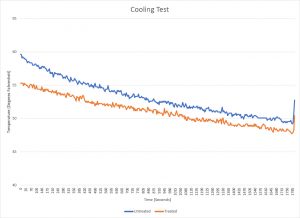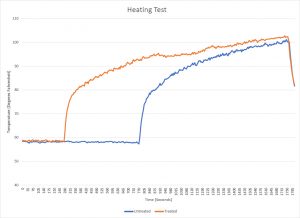
Testing the KoolMaxx AC™ Approach to Removing AC Oil Fouling
The American Society of Heating Refrigerating and Air Conditioning Engineers (ASHRAE) is a global professional association with more than 56,000 members from over 132 nations. The organization is dedicated to advancing the arts and sciences of heating, ventilation, air conditioning and refrigeration to serve humanity and promote a sustainable world. According to ASHRAE research and testing:
- AC systems experience a 7% efficiency loss in the first year
- A 5% efficiency loss in the second year, and
- A 2% loss each year thereafter
ASHRAE has found that performance is degraded by as much as 30% due to the build-up of lubricants on the AC’s internal surfaces.* Higher percentages have been observed in systems 20 years old or older.
* 1998 ASHRAE Handbook, Refrigeration, Chap. 6.7
Some of the techniques used by manufacturers to control migrating oil include the use of mechanical devices, such as separators, skimmers, drums, heat sources, suction risers, traps and pumps. However, according to ASHRAE’s Handbook*, these high-tech designs are not efficient enough to remove all of the unwanted oil. Although the mechanical solutions may reduce the problems of restricted or plugged capillary tubes or sticky expansion valves, they do not resolve the boundary layer oil fouling over time.
* 1998 ASHRAE Handbook, Refrigeration, Chap. 2.9
The Intertek Quality Assurance engineers in their Cortland, New York, laboratories tested the product and found the following results:
Cooling Test

7% improvement in cooling temperature.
After injection of KoolMaxx AC into the system, the unit’s operation was not adversely affected by the substance being introduced into the system (view chart).
Heating Test

10% improvement in heating temperature.
After injection of KoolMaxx AC into the system, the unit’s operation was not adversely affected by the substance being introduced into the system (view chart).
- The lab tested the unit initially as is, without adding into the system any of the KoolMaxx AC to obtain control data.
- The lab technician installed a thermostat, connected to the unit, in the psychrometric testing facility.
- The psychrometric room was set to the specific conditions:
- Cooling: 82 degrees Fahrenheit
- Heating: 60 degrees Fahrenheit
- The thermostat would then initiate the unit to run.
- Then for a 30-minute period, the altering of the facility’s temperature was ceased, and then how the unit altered the temperature in the facility was measured by a thermocouple cable grid.
- Cooling: from 82 degrees Fahrenheit down to 70 degrees Fahrenheit
- Heating: from 60 degrees Fahrenheit up to 75 degrees Fahrenheit
- The technician repeated this process for a total of 3 times in cooling mode and 4 times in heating mode before introducing the KoolMaxx AC into the system.
- The cooling and heating tests were then performed with KoolMaxx AC introduced into the system.
Notes:
- The unit tested was new and a 2.8-ton (34,000 BTU/h cooling, 34,600 BTU/h heating), split-system, single stage heat-pump, Indoor Model Number: FVM4X2400BL, Outdoor Model Number: 25HCE436C300, SEER: 14, HSPF: 8.2
- After injection of KoolMaxx AC into the system, the unit’s operation did not seem adversely affected by the substance being introduced into the system.
- The sample was evaluated May 16, 2017 and tested at the Intertek Cortland Facility.
- The results of the tests are for the technical evaluation by the Coastal Energy Resources LLC only and are applicable only to the test specimen(s) described.
Learn more about ASHRAE at www.ashrae.org.
